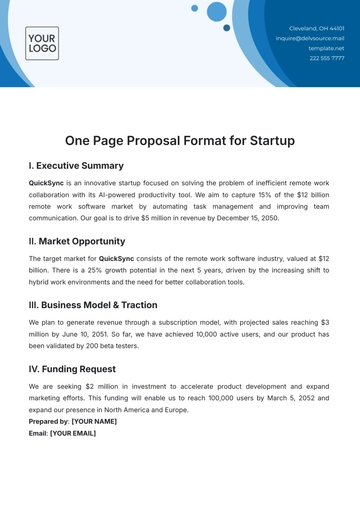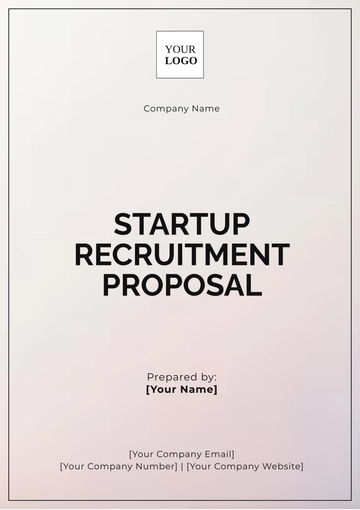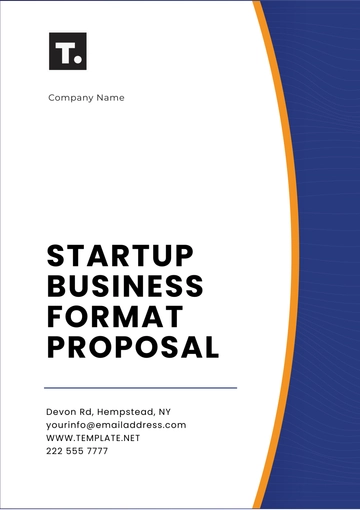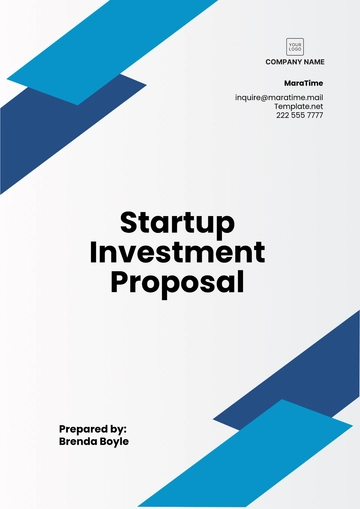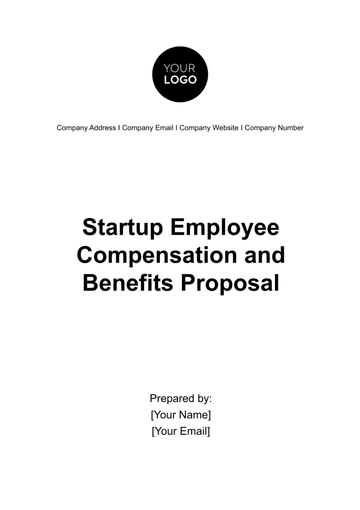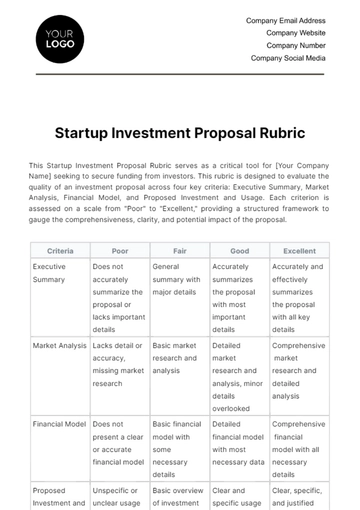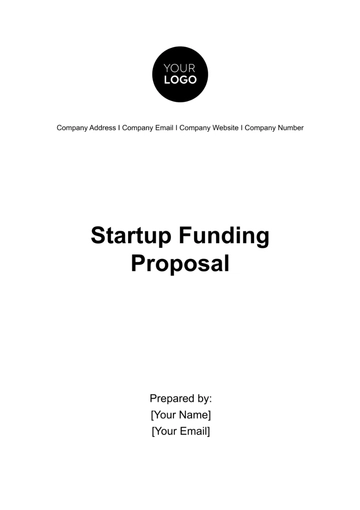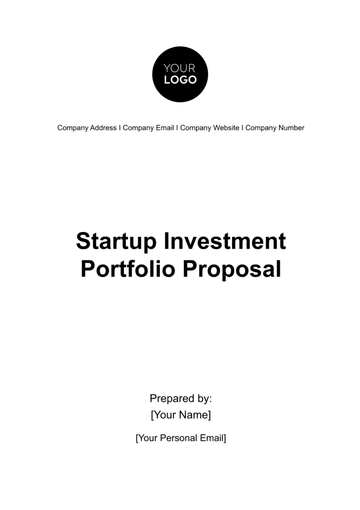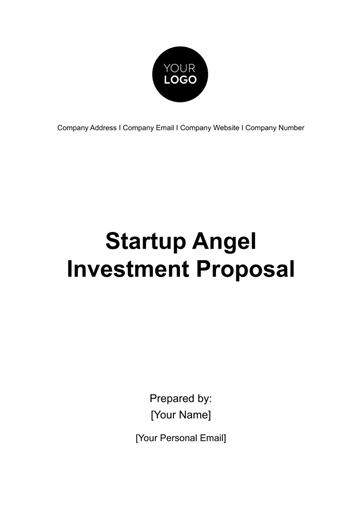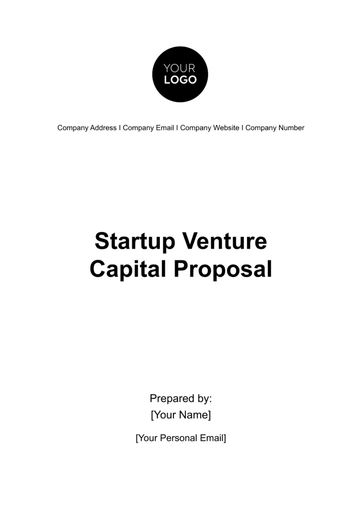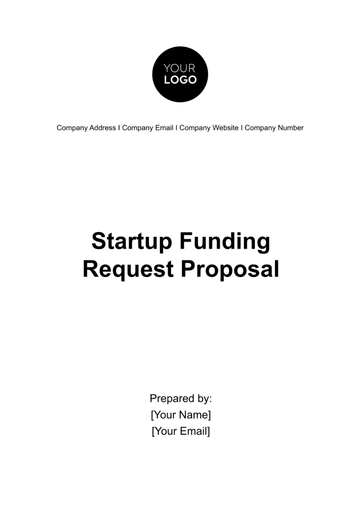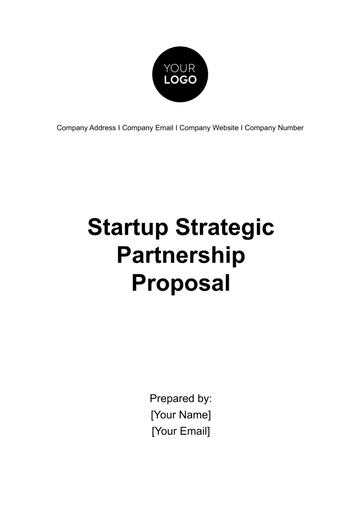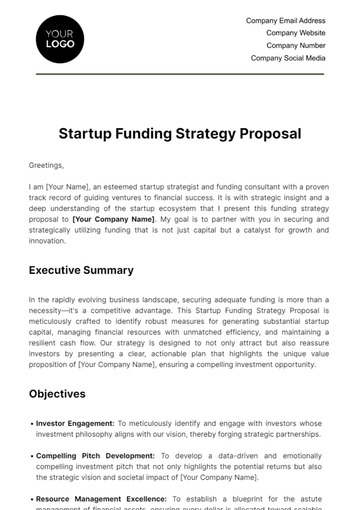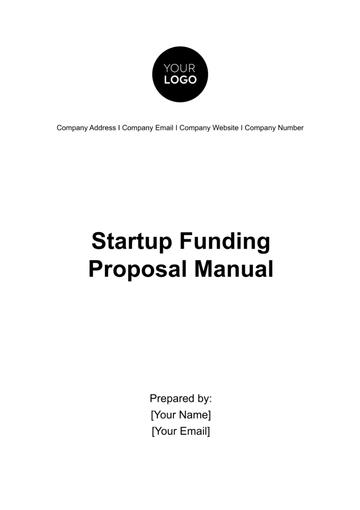Free Startup Funding Proposal
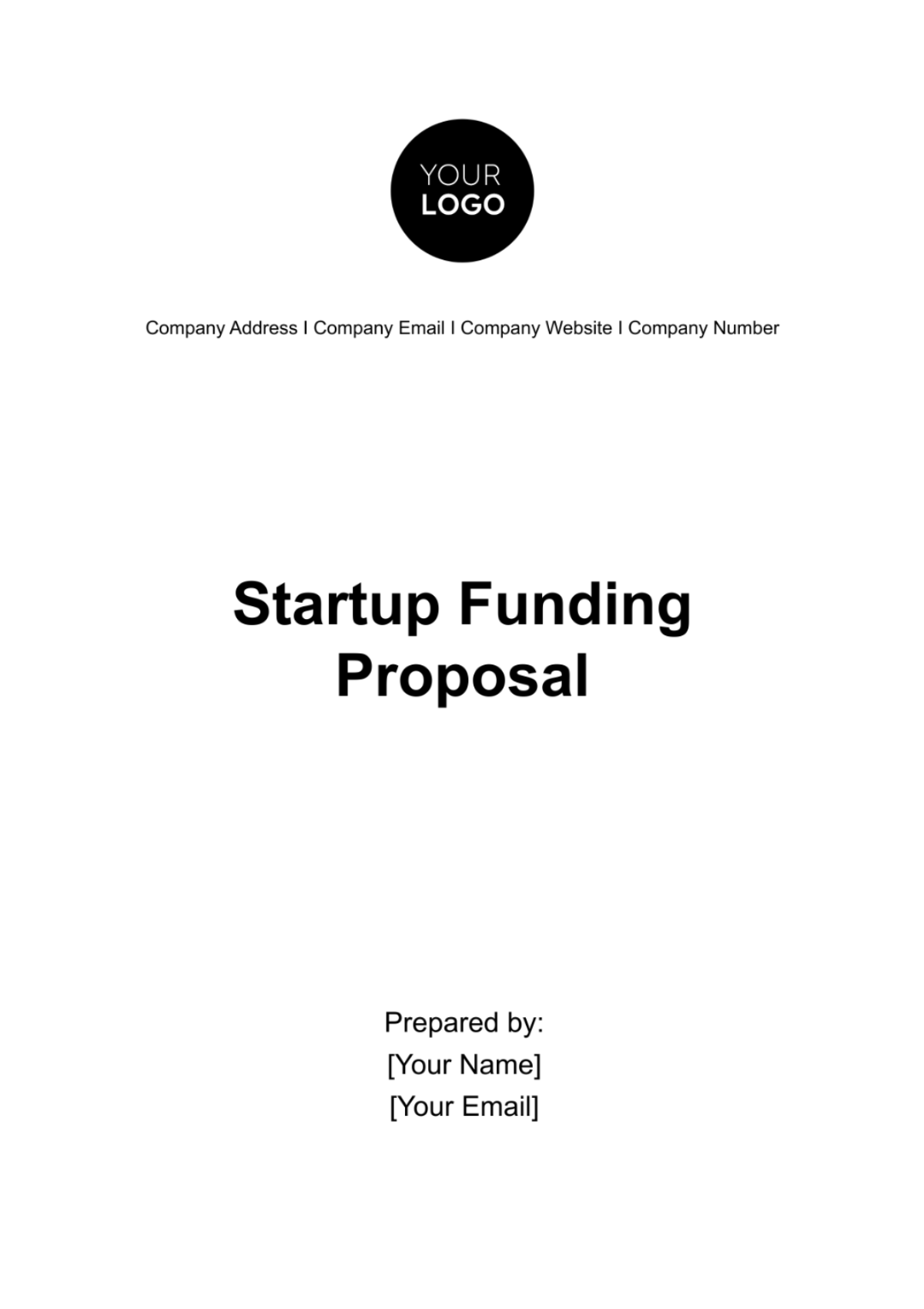
Executive Summary
[Your Company Name], a cutting-edge technology startup based in Silicon Valley, is seeking funding in the amount of [$0,000,000] to support the development and launch of our revolutionary AI-powered virtual assistant, [Product Name]. At [Your Company Name], we are dedicated to leveraging advanced artificial intelligence to simplify and enhance everyday tasks for individuals and businesses alike.
The funding will be allocated towards accelerating product development, expanding our marketing efforts, and scaling our operations to meet growing demand. With a proven track record of innovation and a talented team of experts, [Your Company Name] is poised to disrupt the virtual assistant market and become a leader in AI-driven productivity solutions.
Company Overview
A. Background
[Your Company Name] was founded in [2050] by [John Smith] and [Emily Johnson] with the vision of revolutionizing how people interact with technology. Inspired by the potential of artificial intelligence, our team set out to create a virtual assistant that could understand and respond to natural language commands, making tasks like scheduling appointments, managing emails, and accessing information faster and more intuitive than ever before.
Since our inception, we have made significant strides in developing cutting-edge AI algorithms and building partnerships with leading technology companies. Our commitment to innovation and user-centric design has earned us recognition within the industry and positioned us as a frontrunner in the race to redefine the future of productivity.
B. Mission Statement
[Your Company Name]'s mission is to empower individuals and businesses to achieve more by harnessing the power of artificial intelligence to streamline everyday tasks and enhance productivity. We believe that technology should adapt to human behavior, not the other way around, and are committed to building solutions that seamlessly integrate into users' lives.
Driven by our mission, we have assembled a team of passionate professionals dedicated to pushing the boundaries of what's possible with AI. Together, we are working tirelessly to bring [Product Name] to market and revolutionize the way people work, communicate, and interact with technology.
C. Products/Services
[Product Name] is an AI-powered virtual assistant designed to assist users with a wide range of tasks, from managing schedules and organizing emails to providing real-time information and insights. Our proprietary natural language processing algorithms enable [Product Name] to understand context, learn user preferences, and continuously improve its performance over time. With support for voice commands and integration with popular productivity tools, [Product Name] offers a seamless and intuitive user experience that sets it apart from traditional virtual assistants.
Market Analysis
A. Industry Overview
The AI and virtual assistant industry is experiencing rapid growth, driven by advancements in artificial intelligence and the increasing demand for automation and efficiency. According to Market Research Future, the global virtual assistant market is projected to reach [$00 billion] by [2055], with a compound annual growth rate (CAGR) of [000%] from [2050] to [2055]. Key factors driving this growth include:
Rising adoption of smart devices and digital assistants in homes and workplaces.
Growing emphasis on improving customer service and user experience.
Increasing integration of AI technologies in various industries, including healthcare, finance, and retail.
Leading players in the virtual assistant market include [Amazon (Alexa)], [Google (Google Assistant)], and [Apple (Siri)], among others. However, there is still ample opportunity for innovation and market disruption, particularly in niche segments such as business productivity and enterprise solutions.
B. Target Market
Our target market for [Product Name] includes:
Busy professionals seeking to streamline their workflows and boost productivity.
Small and medium-sized businesses looking for cost-effective solutions to improve operational efficiency.
Enterprises interested in harnessing AI technology to optimize employee performance and customer service.
We will initially focus on demographics where there is a high demand for virtual assistant solutions and where we can effectively differentiate ourselves from competitors.
C. Competitive Analysis
While the virtual assistant market is dominated by major players such as Amazon, Google, and Apple, [Your Company Name] has identified several areas of opportunity and differentiation:
Specialization in business productivity: Unlike general-purpose virtual assistants, [Product Name] is tailored specifically for professionals and businesses, offering advanced features for managing schedules, tasks, and communications.
Superior natural language processing: Our proprietary AI algorithms enable [Product Name] to understand context and user intent more accurately, resulting in faster and more accurate responses to queries and commands.
Integration with third-party applications: [Product Name] seamlessly integrates with popular productivity tools such as Microsoft Office, Google Workspace, and Slack, providing users with a unified platform for managing their work.
Through continuous innovation and a customer-centric approach, [Your Company Name] aims to carve out a significant share of the virtual assistant market and establish [Product Name] as the go-to solution for businesses seeking to leverage AI technology for productivity and efficiency.
Funding Objectives
A. Use of Funds
The [$2,000,000] funding will be allocated as follows:
Category | Allocation |
|---|---|
Product Development | [$000,000] |
Marketing | [$000,000] |
Operations | [$000,000] |
Research & Development | [$000,000] |
B. Milestones
The funding will enable us to achieve the following milestones:
Complete development of [Product Name] and launch beta testing by [Month, Year].
Roll out full-scale marketing campaigns to drive user acquisition and awareness.
Expand our team to support increased demand and accelerate product development efforts.
Secure partnerships with key industry players to enhance product capabilities and market reach.
Financial Projections
A. Revenue Projections
Our revenue projections for the next five years are as follows:
Year | Revenue (USD) |
|---|---|
2050 | [$000,000] |
2051 | [$000,000] |
2052 | [$000,000] |
These projections are based on conservative estimates of user adoption and monetization strategies, including subscription fees, advertising revenue, and potential partnerships with third-party service providers.
B. Expense Projections
Our expense projections for the next five years are as follows:
Category | 2050 | 2051 | 2052 |
|---|---|---|---|
Product Development | [$000,000] | [$000,000] | [$000,000] |
Marketing | [$000,000] | [$000,000] | [$000,000] |
Operations | [$000,000] | [$000,000] | [$000,000] |
Research & Development | [$000,000] | [$000,000] | [$000,000] |
Miscellaneous | [$000,000] | [$000,000] | [$000,000] |
Total Expenses | [$000,000] | [$000,000] | [$000,000] |
C. Profitability Analysis
Based on the revenue and expense projections, our profitability analysis indicates the following:
Year | Gross Profit | Net Profit | Gross Margin | Net Margin |
|---|---|---|---|---|
2050 | [$000,000] | [$000,000] | [00%] | [00%] |
2051 | [$000,000] | [$000,000] | [00%] | [00%] |
2052 | [$000,000] | [$000,000] | [00%] | [00%] |
2053 | [$000,000] | [$000,000] | [00%] | [00%] |
Exit Strategy
A. Acquisition Strategy
[Your Company Name] aims to position itself as an attractive acquisition target for larger technology companies seeking to expand their AI capabilities and market reach. Potential acquirers may include industry giants such as [Google], [Microsoft], or [Salesforce], as well as emerging players looking to gain a foothold in the virtual assistant market.
To facilitate a successful acquisition, we will focus on:
Building a strong and scalable technology platform that offers unique features and capabilities.
Establishing strategic partnerships and alliances to enhance our product offering and market presence.
Demonstrating significant user traction and revenue growth to showcase the potential value of the acquisition.
B. IPO Potential
While an initial public offering (IPO) is not currently a priority for [Your Company Name], we recognize that it may be a viable option in the future as we continue to grow and mature as a company. An IPO could provide access to additional capital for expansion and allow us to further raise our profile in the market.
If pursued, our IPO strategy would involve:
Engaging with investment banks and financial advisors to assess market conditions and determine the optimal timing for going public.
Conducting thorough due diligence to ensure compliance with regulatory requirements and maximize shareholder value.
Communicating our growth strategy and long-term vision to potential investors to generate interest and support for the IPO.
Ultimately, whether through acquisition or IPO, [Your Company Name] is committed to maximizing value for our shareholders and stakeholders as we continue on our journey to revolutionize the virtual assistant market.
Team
A. Management Team
Our management team consists of seasoned professionals with diverse expertise in technology, product development, marketing, and business strategy.
Name | Position | Experience |
|---|---|---|
[John Smith] | CEO & Co-Founder | Over [15] years of experience in technology startups, previously led product development at [Tech Company X]. |
[Emily Johnson] | CTO & Co-Founder | [10+] years of experience in artificial intelligence and software engineering, holds a Ph.D. in Computer Science. |
B. Advisory Board
In addition to our management team, we have assembled a distinguished advisory board comprised of industry experts and thought leaders who provide valuable guidance and strategic insights.
Name | Position | Experience |
|---|---|---|
[Dr. Jane Chen] | AI Advisor | Renowned expert in artificial intelligence, professor of computer science at [University], published [00] papers in AI. |
[Mark Davis] | Business Advisor | Seasoned entrepreneur and investor, founder of [Venture Capital Firm], specializes in technology startups. |
Risk Management
A. Market Risks
As with any business venture, there are inherent risks associated with market dynamics that may impact our company's growth and profitability. These risks include:
Market saturation: The virtual assistant market is highly competitive, with established players and emerging startups vying for market share. A saturated market could make it challenging to differentiate our product and attract new users.
Technological advancements: Rapid advancements in AI technology may outpace our development efforts, leading to potential obsolescence or the need for significant investment to stay competitive.
Regulatory changes: Changes in regulations related to data privacy, cybersecurity, and AI governance could impact our ability to operate and introduce compliance costs.
B. Operational Risks
Operational risks relate to internal factors that may affect our ability to execute our business plan effectively. These risks include:
Technical issues: Software bugs, server outages, or other technical issues could disrupt service delivery and damage our reputation.
Talent acquisition and retention: Recruiting and retaining top talent in a competitive market may prove challenging, affecting our ability to innovate and grow.
Supply chain disruptions: Dependency on third-party vendors for hardware components or cloud services exposes us to the risk of supply chain disruptions that could impact product availability and delivery timelines.
Sustainability Initiatives
A. Environmental Sustainability
[Your Company Name] is committed to minimizing our environmental footprint and promoting sustainability throughout our operations. Key initiatives include:
Energy efficiency: Implementing energy-efficient practices in our offices and data centers to reduce energy consumption and greenhouse gas emissions.
Waste reduction: Implementing waste reduction strategies, such as recycling programs and electronic waste management, to minimize our environmental impact.
Renewable energy: Investing in renewable energy sources, such as solar or wind power, to power our operations and reduce reliance on fossil fuels.
B. Social Responsibility
We recognize the importance of social responsibility and strive to make a positive impact on the communities in which we operate. Our social responsibility initiatives include:
Diversity and inclusion: Promoting diversity and inclusion within our workforce and supporting initiatives that promote equality and opportunity for underrepresented groups.
Community engagement: Partnering with local organizations and charities to support community initiatives, volunteer programs, and philanthropic efforts.
Ethical sourcing: Ensuring that our supply chain partners adhere to ethical labor practices and environmental standards to promote fair and sustainable business practices.
- 100% Customizable, free editor
- Access 1 Million+ Templates, photo’s & graphics
- Download or share as a template
- Click and replace photos, graphics, text, backgrounds
- Resize, crop, AI write & more
- Access advanced editor
Explore the Startup Funding Proposal Template on Template.net, your premier source for business documents. This editable and customizable template streamlines the process of crafting compelling funding proposals for your startup ventures. With our intuitive Ai Editor Tool, tailor the proposal to suit your specific needs and captivate potential investors. Secure the funding you need to turn your startup vision into reality.
You may also like
- Business Proposal
- Research Proposal
- Proposal Request
- Project Proposal
- Grant Proposal
- Photography Proposal
- Job Proposal
- Budget Proposal
- Marketing Proposal
- Branding Proposal
- Advertising Proposal
- Sales Proposal
- Startup Proposal
- Event Proposal
- Creative Proposal
- Restaurant Proposal
- Blank Proposal
- One Page Proposal
- Proposal Report
- IT Proposal
- Non Profit Proposal
- Training Proposal
- Construction Proposal
- School Proposal
- Cleaning Proposal
- Contract Proposal
- HR Proposal
- Travel Agency Proposal
- Small Business Proposal
- Investment Proposal
- Bid Proposal
- Retail Business Proposal
- Sponsorship Proposal
- Academic Proposal
- Partnership Proposal
- Work Proposal
- Agency Proposal
- University Proposal
- Accounting Proposal
- Real Estate Proposal
- Hotel Proposal
- Product Proposal
- Advertising Agency Proposal
- Development Proposal
- Loan Proposal
- Website Proposal
- Nursing Home Proposal
- Financial Proposal
- Salon Proposal
- Freelancer Proposal
- Funding Proposal
- Work from Home Proposal
- Company Proposal
- Consulting Proposal
- Educational Proposal
- Construction Bid Proposal
- Interior Design Proposal
- New Product Proposal
- Sports Proposal
- Corporate Proposal
- Food Proposal
- Property Proposal
- Maintenance Proposal
- Purchase Proposal
- Rental Proposal
- Recruitment Proposal
- Social Media Proposal
- Travel Proposal
- Trip Proposal
- Software Proposal
- Conference Proposal
- Graphic Design Proposal
- Law Firm Proposal
- Medical Proposal
- Music Proposal
- Pricing Proposal
- SEO Proposal
- Strategy Proposal
- Technical Proposal
- Coaching Proposal
- Ecommerce Proposal
- Fundraising Proposal
- Landscaping Proposal
- Charity Proposal
- Contractor Proposal
- Exhibition Proposal
- Art Proposal
- Mobile Proposal
- Equipment Proposal
- Student Proposal
- Engineering Proposal
- Business Proposal




